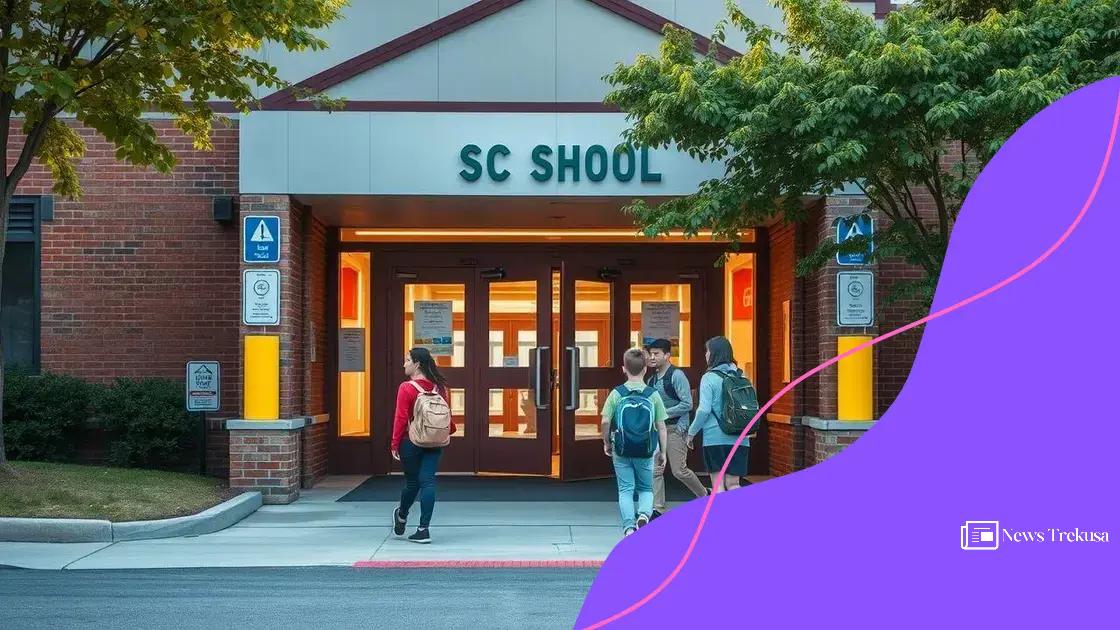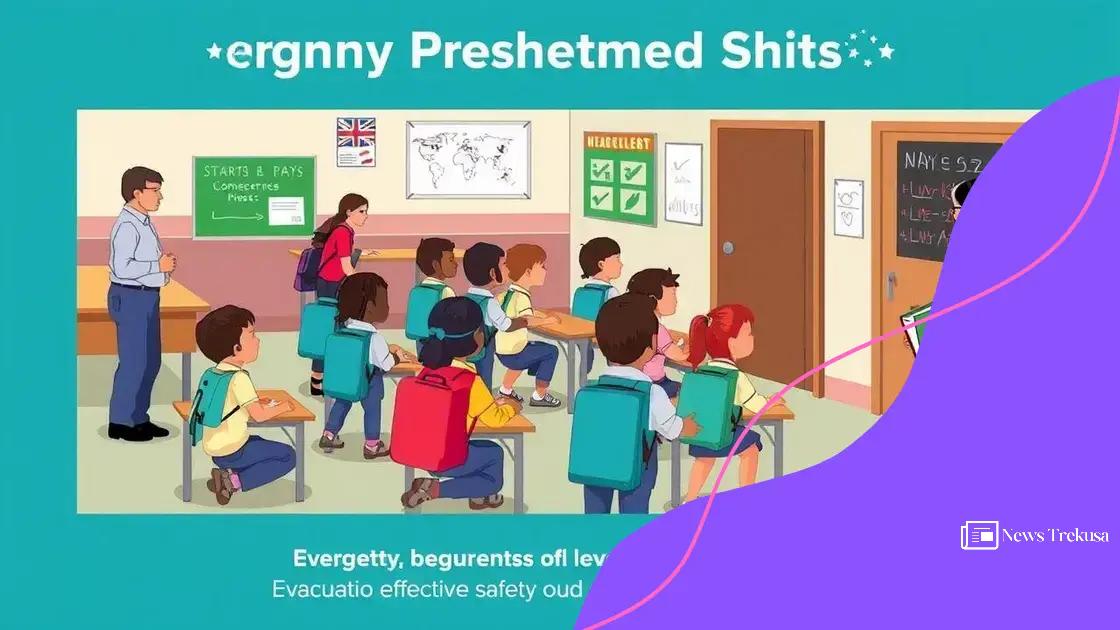School safety protocols that keep students secure

School safety protocols are essential guidelines designed to protect students and staff through effective emergency response plans, clear communication, regular training, and comprehensive safety strategies.
School safety protocols are critical in creating a secure environment for learning and growth. Have you ever wondered how these measures can truly impact student well-being and learning outcomes? In this article, we’ll dive into essential strategies for enhancing school safety.
Understanding school safety protocols
Understanding school safety protocols is essential for creating a secure environment for students. These protocols not only enhance safety but also promote a sense of well-being among educators and families. In this section, we will explore the various dimensions of effective safety measures.
Key Principles of Safety Protocols
Effective safety protocols encompass a range of strategies that can adapt to different situations. The core principles include:
- Prevention: Strategies that minimize risks before incidents happen.
- Preparedness: Plans to respond to emergencies efficiently.
- Response: Actions taken during an incident to protect students and staff.
- Recovery: Processes to restore normalcy after an incident.
Each of these principles plays a vital role in enhancing school safety. Having clear protocols helps everyone understand their roles during an emergency.
Creating a Safe Environment
Creating a safe school environment involves more than just physical safety. It includes emotional support and fostering a community where everyone feels valid. Incorporating anti-bullying measures is an example of how emotional safety plays a crucial role. Programs that focus on social-emotional learning provide teachers with tools to address students’ feelings and promote positive interactions.
Additionally, regular drills and training sessions are fundamental. They ensure that both students and staff know what to do in an emergency. Safety education helps everyone feel prepared and reduces anxiety during actual events.
Schools can benefit from partnerships with local law enforcement and community organizations. These partnerships can enhance safety by providing resources and training to staff and students. Engaging the community in safety discussions builds trust and enhances collective efforts to ensure a safe learning space.
In summary, understanding school safety protocols is crucial for creating environments where students can thrive. By keeping these principles and practices in mind, schools can foster a culture of safety that supports both academic achievement and emotional well-being.
Key components of effective safety strategies
Key components of effective school safety strategies are essential in ensuring that students can learn in a safe environment. Understanding these components helps schools to implement the most suitable measures.
Risk Assessment
The first step in creating effective safety strategies is conducting a thorough risk assessment. This process involves identifying potential risks and vulnerabilities specific to the school environment. Factors to consider include:
- Surrounding neighborhood conditions
- Physical layout of the school
- Student population dynamics
- Past incidents and response evaluations
By understanding these risks, schools can tailor their safety protocols to address the most pressing concerns.
Communication Plans
Another vital component is having clear communication plans. These plans ensure that everyone knows what to do in the event of an emergency. Communication can include:
- Regular updates to staff and students
- Emergency contact lists
- Use of loudspeakers and text alerts
- Regular drills to practice response
Effective communication fosters a sense of security and prepares the entire school community to react quickly.
Moreover, technology plays a significant role in enhancing safety strategies. From surveillance cameras to emergency alert systems, schools can leverage various tools to monitor and respond to incidents. Technology helps in maintaining a secure environment where students can focus on learning without fear.
Lastly, training plays a crucial role. Regular professional development for staff on emergency procedures and safety protocols ensures that they are prepared to handle any situation. This training should also include student involvement, helping students understand their roles in maintaining a safe school.
Emergency preparedness in educational settings

Emergency preparedness in educational settings is vital for ensuring the safety of students and staff. Being ready for unexpected situations can make all the difference in a crisis. Understanding the steps involved is a crucial part of creating a secure environment.
Creating an Emergency Plan
Every school should have a clear emergency plan. This plan outlines procedures for various scenarios, such as natural disasters or security threats. Key components of an emergency plan include:
- Evacuation Routes: Clearly marked paths that students and staff can follow during emergencies.
- Assembly Points: Safe locations where everyone can gather after evacuating the building.
- Communication Guidelines: Procedures for notifying parents and emergency services.
- Designated Roles: Assigning responsibilities to staff members during an emergency.
By having a detailed plan, schools can respond swiftly and effectively, minimizing confusion and maximizing safety.
Training and Drills
Regular training and drills are essential components of emergency preparedness. Conducting drills helps students and staff become familiar with the procedures. Drills should cover different scenarios, including:
- Fire evacuations
- Lockdown situations
- Severe weather responses
- Emergency medical situations
Through consistent practice, everyone can build confidence and improve their response times during an actual emergency, which is crucial for maintaining safety.
Additionally, schools should evaluate their preparedness regularly. This involves reviewing response plans and updating them based on new information or past incidents. Keeping the community informed about emergency procedures fosters a culture of safety that reassures parents and students alike.
Moreover, collaboration with local emergency services can enhance preparedness efforts. Engaging local police, fire departments, and health agencies can provide schools with additional support and resources. These partnerships can lead to better training sessions and resources, ultimately making schools safer for everyone.
Role of communication in school safety
The role of communication in school safety cannot be overstated. Effective communication strategies help ensure that everyone in the school community understands their roles during emergencies. Clear lines of communication can save lives and reduce panic.
Establishing Communication Protocols
Establishing protocols is essential for ensuring timely and accurate information dissemination. Schools should have a plan that outlines how to communicate during an emergency. This might include:
- Emergency Alerts: Text alerts and emails to inform students and parents about emergencies.
- Public Address Systems: Using loudspeakers to convey important instructions quickly.
- Designated Spokespersons: Appointing a trusted individual to share information with the media and community.
By having reliable communication methods in place, schools can prevent confusion and misinformation.
Engagement with the School Community
Engaging the entire school community strengthens communication efforts. Schools should regularly communicate with students, parents, and staff about safety procedures. This can be done through:
- Workshops and safety meetings
- Newsletters and social media updates
- Information sessions for parents
When everyone is informed about safety measures, they will feel more secure and prepared.
Moreover, during emergencies, it’s crucial for school leaders to communicate updates as quickly as possible. Quick updates can reduce anxiety and provide the community with a sense of control. Transparency about the situation helps everyone understand the steps being taken to ensure safety.
Finally, after an emergency situation, schools should continue communication through follow-ups. This includes sharing information about recovery efforts and support services available to students and staff. Ongoing communication fosters a caring environment that helps in the healing process.
Training staff for better safety management
Training staff for better school safety management is crucial in creating a secure learning environment. When staff are well-trained, they can respond effectively during emergencies, reducing risks and ensuring student safety.
Comprehensive Safety Training Programs
Schools should implement comprehensive training programs that cover various topics related to safety. Essential topics include:
- Emergency Procedures: Understanding protocols for different types of emergencies, such as fires, lockdowns, and natural disasters.
- First Aid and CPR: Basic medical training that equips staff to assist injured students and colleagues.
- Behavioral Management: Techniques to identify and address behavioral issues that may escalate into safety concerns.
- Communication Skills: Effective ways to convey information during crises, ensuring clarity and understanding.
By covering these topics, staff members gain confidence and knowledge to handle various safety scenarios.
Regular Drills and Simulations
Regular drills and simulations are vital for reinforcing training. These activities provide hands-on experience, allowing staff to practice their roles in realistic scenarios. Schools should conduct drills for:
- Fire evacuations
- Lockdown situations
- Medical emergencies
These exercises help identify areas for improvement and ensure everyone knows their responsibilities during actual emergencies.
Additionally, feedback sessions after drills can promote discussion and enhance learning. Staff can share their experiences and suggest improvements, fostering a team-oriented approach to safety. When staff are involved in the process, they feel more invested in maintaining a safe environment.
Finally, ongoing professional development is essential. Safety strategies evolve, and so should training programs. Schools should regularly update training to incorporate new information, technologies, and best practices. Keeping staff informed and trained helps maintain an effective safety management system.
In summary, effective school safety protocols are essential for creating a secure learning environment. By understanding the key components of safety strategies, preparing for emergencies, and ensuring clear communication, schools can enhance the overall safety of students and staff. Training and engaging the school community also play critical roles in managing safety effectively. Let’s work together to build a safer school environment for everyone!
FAQ – Questions about School Safety Protocols
What are the key components of effective school safety strategies?
Key components include risk assessment, communication protocols, emergency plans, and regular training for staff.
How often should schools conduct safety drills?
Schools should conduct safety drills at least twice a year to ensure staff and students are familiar with emergency procedures.
What role does communication play in school safety?
Effective communication ensures that everyone knows their roles during an emergency and helps to prevent panic and confusion.
Why is training staff important for safety management?
Training equips staff with the knowledge and skills they need to respond effectively during emergencies, improving overall safety.
SEE MORE CONTENT
